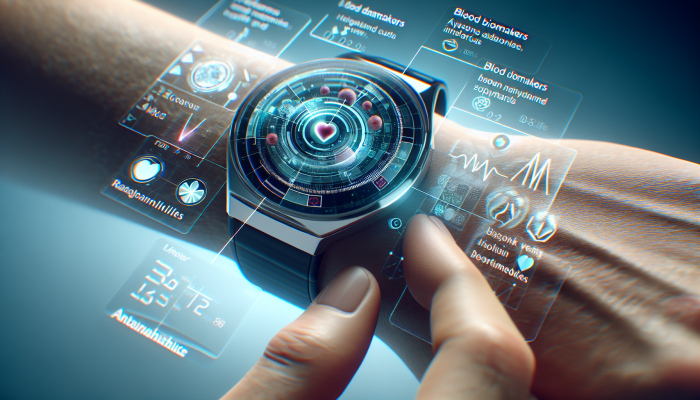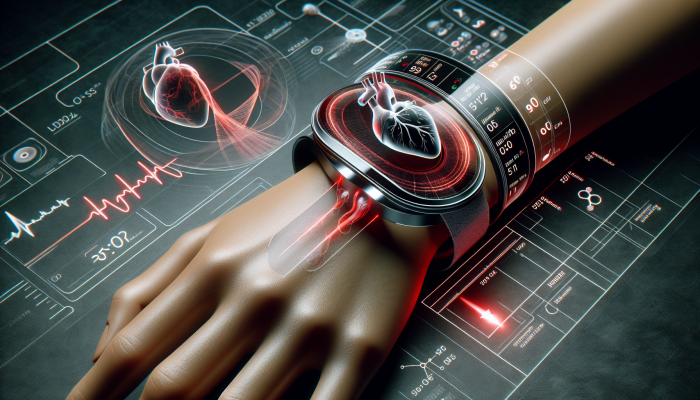Unlocking the Future of Health: An In-Depth Guide to Wearable Blood Test Technology
Wearable blood test technology is revolutionizing the field of personal health monitoring, offering invaluable insights into our biological conditions without the need for traditional and often inconvenient blood draws. This cutting-edge technology allows users to continuously and non-invasively monitor various blood parameters, greatly improving their ability to manage their health proactively. By utilizing advanced sensors, these devices extract data through the skin, analyzing changes in blood composition and providing real-time insights into a variety of health issues. With the integration of innovative materials and sophisticated designs, these wearables deliver accurate readings that empower individuals to take control of their health journeys, facilitating informed decision-making and enhancing overall wellness.
Diving Deeper into the Functionality and Use Cases of Wearable Blood Test Technology

To fully appreciate the transformative nature of wearable blood test technology, it’s essential to explore its definition and the foundational principles behind its functionality. This technology includes a variety of devices expressly designed to detect specific biomarkers present in the blood. Often resembling traditional wearables such as smartwatches and fitness trackers, these devices incorporate advanced sensors that can identify biochemical changes occurring within the body.
The operation of these innovative devices hinges on the use of several types of sensors, including optical sensors, electrochemical sensors, and microfluidic systems. Optical sensors utilize light absorption or fluorescence to monitor key blood parameters like glucose and cholesterol levels. In contrast, electrochemical sensors depend on chemical reactions to measure the concentrations of specific substances, providing insights into metabolic functions. Microfluidic systems are adept at managing tiny fluid volumes for quick analysis, making them well-suited for rapid testing applications.
Key Components of Wearable Blood Test Technology: Analyzing Sensors and Material Choices
The effectiveness of wearable blood test technology is significantly influenced by the quality of its components, especially the sensors that are crucial for delivering accurate measurements. The materials commonly used in these sensors include conductive polymers, nanomaterials, and biocompatible substances, all of which promote safe interactions between the sensors and biological fluids.
For example, conductive polymers have the ability to modify their electrical properties in response to chemical stimuli, making them particularly effective for glucose monitoring. Nanomaterials like graphene and carbon nanotubes greatly improve sensitivity and specificity, allowing for the detection of extremely low concentrations of biomarkers. Additionally, using biocompatible materials ensures that the device remains safe for prolonged skin contact, minimizing the likelihood of irritation or allergic reactions.
Current Trends in Wearable Blood Test Technology: Market Insights and Future Directions
The market for wearable blood test technology is experiencing rapid growth, fueled by an increasing demand for proactive health management solutions. Recent projections indicate that this market could reach billions of pounds by the mid-2030s, driven by technological advancements and a wider consumer base. Significant players from both the healthcare and technology sectors are dedicating considerable resources to research and development, aiming to enhance the functionality and accuracy of these devices.
Looking forward, the anticipated incorporation of artificial intelligence and machine learning will be crucial in advancing wearable blood test technology. These sophisticated technologies can analyze vast amounts of data, detecting patterns and trends that might not be immediately visible to human analysts. As a result, these devices will provide timely feedback and predictive insights, promoting a more personalized healthcare experience.
Understanding the Science Behind Wearable Blood Test Technology: A Comprehensive Overview

By exploring the scientific principles that underpin wearable blood test technology, we can uncover the mechanisms that allow these devices to operate effectively. A comprehensive understanding of biometric sensing, data accuracy, and integration with health applications is vital for realizing the full potential of this groundbreaking technology.
Unraveling Biometric Sensing: How Accurate Blood Parameter Measurements Are Achieved
Biometric sensing serves as the backbone of wearable blood test technology. These devices are expertly designed to evaluate blood parameters such as glucose, lactate, and electrolytes. Through the use of state-of-the-art sensing technologies, they can monitor real-time fluctuations in these parameters, delivering essential health information to users.
For instance, continuous glucose monitors (CGMs) feature a small sensor that is placed just beneath the skin’s surface, facilitating the monitoring of glucose levels in interstitial fluid. This sensor transmits data to a connected smartphone or device, allowing users to keep track of their glucose levels throughout the day. This non-invasive method enhances user comfort while enabling ongoing monitoring without the pain associated with traditional finger pricks.
Ensuring Accurate Data: Best Practices for Reliable Results from Wearable Blood Test Devices
Data accuracy is a fundamental aspect of wearable blood test technology. Manufacturers are focused on refining sensor technology, calibration techniques, and data algorithms to guarantee trustworthy results. Thorough testing and validation procedures are essential to ensure that readings obtained from these devices closely match those from conventional laboratory methods.
Moreover, advancements in machine learning enable these devices to adapt based on user data over time, improving both accuracy and reliability. The algorithms can account for individual differences by analyzing historical data, resulting in more precise readings. This capability boosts user confidence and supports more effective health management.
Streamlining Health Applications: Integrating Data Transfer and Analysis for Optimal User Experience

One of the standout features of wearable blood test technology is its seamless integration with health applications. This capability allows users to track their health metrics over time, gaining meaningful insights into their overall wellness. The data collected by the wearable device can be transmitted to smartphones or tablets, enabling users to observe trends, establish personal wellness goals, and receive customized recommendations based on their health information.
Furthermore, health applications can facilitate data sharing with healthcare professionals, promoting a collaborative approach to chronic condition management. This connectivity empowers users and enhances the efficiency of healthcare delivery, enabling timely interventions as needed.
Expansive Applications of Wearable Blood Test Technology: Transformative Use Cases and Advantages
The practical uses of wearable blood test technology are vast and varied, covering multiple domains such as diabetes management, athletic performance enhancement, and chronic disease surveillance. Each application showcases the unique strengths of these devices and their potential to reshape health management practices.
Transforming Diabetes Management: Continuous Monitoring for Enhanced Glucose Regulation
One of the most significant impacts of wearable blood test technology is evident in diabetes management. Continuous glucose monitors (CGMs) have become indispensable tools for individuals living with diabetes, offering real-time data on glucose levels. This ongoing monitoring empowers users to make informed decisions about their diet, exercise, and medication management, ultimately leading to improved glycemic control.
Users are alerted to both high and low glucose levels, enabling immediate action to prevent complications. Many CGMs are now integrated with insulin pumps, creating a closed-loop system that automates insulin delivery based on real-time glucose readings, thereby enhancing overall diabetes management.
Boosting Sports and Fitness Performance: Utilizing Blood Analysis for Maximum Efficiency
In the realm of sports and fitness, wearable blood test technology is increasingly being adopted as athletes aim to optimize their performance. By monitoring key blood parameters such as lactate levels and electrolyte balance, athletes gain critical insights into their physical condition and recovery requirements.
For example, tracking lactate levels during training can help athletes identify their ideal training zones, ensuring they maximize their efforts while avoiding overexertion. Additionally, monitoring hydration levels through blood analysis allows athletes to maintain peak performance and reduce the risk of dehydration-related health issues.
Monitoring Chronic Conditions: Vigilantly Assessing Issues Such as Heart Disease and Kidney Function
Beyond diabetes, wearable blood test technology is essential for monitoring chronic diseases such as heart disease and kidney dysfunction. By continuously tracking pertinent biomarkers, these devices offer crucial data that can guide treatment adjustments and lifestyle changes.
For individuals with heart disease, monitoring factors like cholesterol levels and blood pressure can help detect potential health complications before they escalate. In cases of kidney disease, tracking electrolyte levels and other biomarkers enables timely interventions, ultimately resulting in better patient outcomes and improved health management strategies.
Smart Consumer Insights for Choosing Wearable Blood Test Technology: Key Considerations for Informed Purchases
As wearable blood test technology becomes more accessible to the general public, it’s crucial for consumers to be aware of the key elements to consider when selecting a device. Factors such as device features, user experience, and privacy concerns significantly affect purchasing decisions.
Identifying the Ideal Device: Key Elements to Consider When Investing in Wearable Blood Test Technology
When selecting a wearable blood test technology device, consumers should assess several critical factors. First, it’s essential to determine which specific health metrics they wish to monitor, as various devices cater to different needs. For instance, individuals managing diabetes may prioritize glucose monitoring, while fitness enthusiasts might focus on lactate and hydration metrics.
Moreover, the accuracy and reliability of the device are of utmost importance. To evaluate performance, consumers should conduct comprehensive research, reviewing product testimonials, clinical validations, and user experiences. Other significant factors include device comfort, battery life, and compatibility with smartphones or health applications, all contributing to an enhanced user experience.
Improving User Experience: Prioritizing Comfort, Usability, and Wearability
The user experience associated with wearable blood test technology is a vital factor that can greatly influence adoption rates. Devices should be thoughtfully designed to emphasize comfort and wearability, ensuring that they can be used for extended periods without causing discomfort or irritation.
In addition, ease of use is crucial; users should be able to navigate the device and its accompanying application intuitively. Clear instructions and user-friendly interfaces can significantly enhance the overall experience, encouraging consistent usage and more effective health monitoring for users.
Protecting Data Privacy and Security: Ensuring Confidentiality of Personal Health Information
As with any technology that gathers personal health data, privacy and security are critical concerns for users of wearable blood test technology. Consumers must ensure that the devices they choose comply with data protection regulations and incorporate robust security measures to protect their sensitive information.
Furthermore, understanding how data is stored, shared, and utilized is essential for informed decision-making. Users should opt for devices that provide transparency regarding data-handling practices and allow them to manage privacy settings, ensuring that their health information remains confidential and secure.
Innovative Developments Shaping Wearable Blood Test Technology: Exploring the Latest Advancements and Trends
The arena of wearable blood test technology is rapidly evolving, with ongoing innovations extending the capabilities of these devices. From miniaturization to multi-parameter testing, each new development unveils exciting possibilities for enhanced health monitoring.
Miniaturization Trends: Developing Smaller and More Discreet Wearable Devices
One of the most captivating trends in wearable blood test technology is miniaturization. As technological advancements progress, manufacturers are discovering innovative ways to create smaller, more discreet devices that can be comfortably worn throughout the day. This trend is particularly appealing to consumers who wish to maintain a low profile while managing their health.
Miniaturized devices often employ advanced materials and innovative manufacturing techniques to deliver outstanding performance without sacrificing user comfort. This focus on compact design not only improves wearability but also broadens the potential uses of wearable blood test technology in daily life.
The Emergence of Multi-Parameter Testing: Devices Capable of Simultaneously Measuring Multiple Blood Markers
The ability to perform multi-parameter testing represents another significant advancement in wearable blood test technology. New devices capable of simultaneously measuring various blood markers are being developed, furnishing users with a comprehensive overview of their health status.
This breakthrough enables more efficient monitoring, as individuals can obtain multiple readings from a single device, reducing the need for multiple wearables. For instance, devices that track glucose, lactate, and hydration levels can offer athletes critical insights into their performance, all from one source, thereby streamlining their training regimen.
Smartwatch Integration: Combining Blood Testing with Comprehensive Health Metrics
The integration of wearable blood test technology with smartwatches marks a significant advancement in health monitoring. Many leading smartwatches are now incorporating blood testing features, allowing users to access a wealth of health information from a single device. This integration enhances user experience, enabling individuals to track their blood parameters alongside other vital health metrics, including heart rate, activity levels, and sleep patterns.
Moreover, this holistic approach to health monitoring encourages deeper insights and more informed decision-making. Users can observe how various lifestyle factors, such as diet and exercise, impact their blood parameters, resulting in more effective health management strategies.
Insights from Healthcare Professionals on Wearable Blood Test Technology: Expert Opinions
From a healthcare perspective, wearable blood test technology offers exciting opportunities for improving patient care and outcomes. Key considerations such as clinical validation, telemedicine integration, and regulatory hurdles are crucial in influencing the adoption of these devices in professional settings.
Establishing Clinical Validation: Supporting Research and Trials for Wearable Blood Test Technology
Clinical validation is vital for establishing the credibility of wearable blood test technology. Thorough studies and trials are necessary to confirm that these devices provide accurate and reliable results compared to traditional laboratory testing methods. Numerous research projects have validated the effectiveness of devices like continuous glucose monitors, emphasizing their significance in diabetes management.
As more clinical evidence becomes available, healthcare providers are increasingly inclined to recommend these devices to their patients. This validation not only aids individual health management but also fosters broader acceptance of wearable technology within healthcare systems.
Enhancing Telemedicine Integration: Utilizing Wearable Data for Remote Patient Monitoring
The integration of wearable blood test technology with telemedicine represents a transformative advancement in healthcare delivery. By enabling remote patient monitoring, these devices provide healthcare professionals with real-time data that can inform treatment decisions and interventions.
This approach is particularly advantageous for managing chronic conditions, allowing for continuous oversight without necessitating frequent in-person visits. Patients can share their data with healthcare providers, facilitating timely modifications to treatment plans tailored to their unique needs.
Navigating Regulatory Challenges: Overcoming Approval Processes for Medical Devices
Regulatory considerations are crucial in the development and implementation of wearable blood test technology. Manufacturers must navigate complex approval processes to ensure their devices meet safety and efficacy standards. Regulatory bodies, such as the FDA in the United States and the MHRA in the UK, require comprehensive documentation and testing to validate the performance of medical devices.
As the landscape of wearable technology continues to evolve, regulatory frameworks are also adapting to encompass new innovations. This dynamic environment presents both challenges and opportunities for manufacturers aiming to introduce safe and effective products to the marketplace.
Envisioning the Future of Wearable Blood Test Technology: Anticipated Innovations and Trends
As we look ahead, the potential of wearable blood test technology is vast. Concepts such as personalized medicine, preventive care, and ethical considerations will play pivotal roles in shaping future health monitoring technologies.
Advancing Personalized Medicine: Customizing Treatments Based on Continuous Blood Analysis
One of the most promising aspects of wearable blood test technology is its ability to facilitate personalized medicine. By continuously monitoring blood parameters, healthcare professionals can tailor treatments to meet the specific needs of each patient, optimizing outcomes while minimizing adverse effects.
This individualized approach enables more precise adjustments to medication dosages, lifestyle recommendations, and treatment plans based on real-time data. As a result, patients can experience improved health outcomes and a better quality of life.
Promoting Preventive Care: Enabling Early Detection of Health Risks
Preventive care is another critical area where wearable blood test technology can have a transformative effect. By facilitating early detection of health risks, these devices empower individuals to take proactive steps to protect their well-being.
For instance, continuous monitoring of biomarkers can reveal risk factors for conditions like heart disease or diabetes, prompting timely interventions. This shift towards preventive care not only enhances individual health but also eases the burden on healthcare systems by reducing the prevalence of chronic diseases.
Addressing Ethical and Social Considerations: Navigating the Implications of Widespread Adoption of Wearable Blood Test Technology
As the adoption of wearable blood test technology becomes more commonplace, it is crucial to consider the ethical and social implications that accompany its use. Concerns about data privacy, equitable access to technology, and potential disparities in health monitoring may arise as these devices gain traction.
Ensuring that everyone has equal access to wearable technology and its associated health benefits is essential for promoting health equity. Additionally, prioritizing transparent data practices and robust security measures is vital to build trust among users and protect the confidentiality of their health information.
Frequently Asked Questions About Wearable Blood Test Technology: Comprehensive Answers
How accurate are wearable blood test devices compared to traditional methods?
Devices designed for wearable blood testing prioritize accuracy and often yield results comparable to traditional methods. However, factors such as calibration and sensor technology can influence their precision.
Can wearable blood test technology replace regular doctor visits?
While wearable blood test technology provides vital insights, it is intended to complement regular doctor visits rather than replace them. Continuous monitoring enhances health management but does not substitute for professional medical guidance.
What potential risks are associated with using wearable blood test technology?
Potential risks include inaccurate readings, skin irritation from sensors, and concerns related to data privacy. It’s crucial to choose reliable devices and follow safe usage guidelines.
How frequently should I wear my blood testing device?
For optimal results, users should wear their devices continuously to ensure comprehensive monitoring of blood parameters and gain valuable health insights.
Are there any age restrictions for using wearable blood test technology?
Most wearable blood test devices are designed for adult use. However, it is advisable for guardians to consult a healthcare professional before using them for children or individuals with specific health conditions.
Can individuals with allergies use wearable blood test technology?
Individuals with allergies should review the materials used in the device and consult their healthcare provider beforehand to ensure safety and avoid allergic reactions.
How do I care for my wearable blood test device?
Regular cleaning and proper storage are essential for maintaining your device. Follow the manufacturer’s guidelines for the care and maintenance to ensure its longevity.
Will my insurance cover the cost of wearable blood test technology?
Insurance coverage varies by provider and policy. It is recommended to check with your insurance company to determine if they cover wearable blood test devices.
Can I share my wearable blood test data with my doctor?
Many devices allow data sharing with healthcare professionals, enhancing collaboration and management of your health with real-time information.
What should I do if I experience discomfort while using my device?
If discomfort occurs, remove the device immediately and consult your healthcare provider. They can determine whether the device is suitable for you or recommend alternatives.
Connect with us on Facebook!
This Article Was First Found On https://bloodtest.co.uk
The Article: Wearable Blood Test Technology Transforms Health Monitoring appeared first on: https://ezbloodtest.com
The Article Wearable Blood Test Technology Revolutionizes Health Tracking Was Found On https://limitsofstrategy.com

